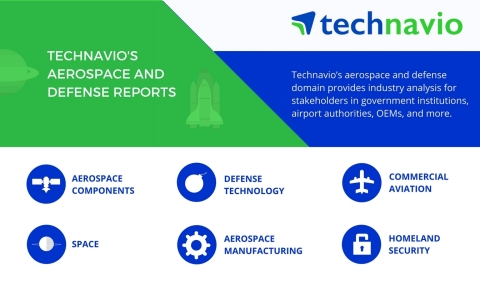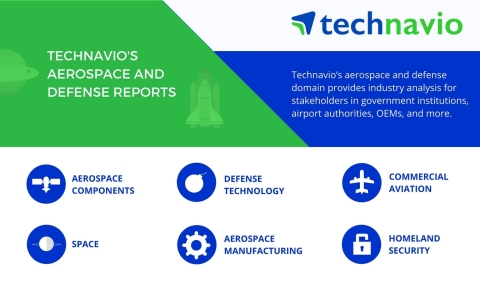LONDON--(BUSINESS WIRE)--Technavio market research analysts forecast the global commercial aircraft catalytic ozone converter market to grow at a CAGR of more than 5% during the forecast period, according to their latest report.
The report further segments the global commercial aircraft catalytic ozone converter market by application (narrow-body aircraft, wide-body aircraft, and regional jet) and by geography (the Americas, APAC, and EMEA).
Avail Technavio’s Year-End Special offer: Get 50% off on this report and all other reports covering industries like ICT; energy; food and beverage; healthcare and life sciences; automotive; industrial automation; education; and many more. Offer valid only from Dec 18 – Jan 7.
Technavio analysts highlight the following three market drivers that are contributing to the growth of the global commercial aircraft catalytic ozone converter market:
- Increased production and procurement of new aircraft
- Growing preference for enhanced flight experience
- Regulatory obligations
Looking for more information on this market? Request a free sample report
Technavio’s sample reports are free of charge and contain multiple sections of the report including the market size and forecast, drivers, challenges, trends, and more.
Increased production and procurement of new aircraft
Commercial aircraft OEMs are actively working towards the development of new-generation aircrafts that have enhanced fuel-efficient features. As the resistance offered by air at higher altitudes is very less, aircraft cruising altitudes above 40,000 feet can save a significant amount of fuel. In the coming 20 years, the demand for highly fuel-efficient aircraft is likely to double. This is mainly due to the increase in passenger traffic in developing countries in APAC and EMEA. The induction of new aircraft is essential for this year-over-year increase in air traffic.
According to Ramyabrata Chakraborty, a lead analyst at Technavio for aerospace components research, “A major propelling factor for the growth of the global commercial aircraft catalytic ozone converter market will be the increasing orders for newer-generation, fuel-efficient aircraft during the forecast period. In addition, the installation of the efficient air management systems will minimize the ozone content, thereby ensuring a comfortable environment within the cabin for passengers and providing aircraft safety.”
Growing preference for enhanced flight experience
Comfort and safety play a crucial role in design consideration for an aircraft. In the absence of a controlled environment, modern commercial aircraft operate in an environment that is not ideally suited for human survival. Thus, aircraft are installed with complex systems to provide safety and comfort to passengers.
Due to the dry, cramped, and pressurized cabin, air travel sometimes becomes very daunting for passengers. As per international standards, aircraft flying at altitudes around 10,000 feet are required to maintain the cabin pressure for 8,000 feet altitude. The newer generation aircraft comes are installed with ECS that has a catalytic ozone converter that ensures supply of good-quality air that is enriched with oxygen. This ensures safety and comfort for passengers. Currently, the cabin pressures can be set at an environment at altitudes ranging between 5,000 and 6,000 feet.
Regulatory obligations
Ozone is an extremely toxic deep lung irritant. It causes nausea, headache, dizziness, fatigue shortness of breath, coughing, chest pain, loss of coordination, and burning sensation in the nose and throat. It also decreases the ability to concentrate. The undesirable effects of toxic ozone did not come to public attention until 1977.
Airplanes flew at a lower altitude of about 25,000-35,000 feet, where the concentration of ozone is relatively low, before the first oil crisis in 1973. However, to achieve the benefit of lower fuel consumption, airliners now regularly operate at altitudes of up to 45,000 feet, where the concentration of ozone is much higher.
“Flying at higher altitudes ensures a reduction in fuel consumption, however, the higher concentration of ozone at these altitudes makes it mandatory for aircraft manufacturers to integrate efficient ozone converters. Therefore, factors such as the advantage of fuel consumption and mandatory regulations directing reduced ozone levels in aircraft cabin will drive the market during the forecast period,” says Ramyabrata.
Browse Related Reports:
- Global Nanotech-Enabled Aircraft Power Solutions Market 2017-2021
- Global Commercial Aircraft Wing Market 2017-2021
- Global Commercial Aircraft Airborne Collision Avoidance System (ACAS) Market 2017-2021
About Technavio
Technavio is a leading global technology research and advisory company. Their research and analysis focuses on emerging market trends and provides actionable insights to help businesses identify market opportunities and develop effective strategies to optimize their market positions.
With over 500 specialized analysts, Technavio’s report library consists of more than 10,000 reports and counting, covering 800 technologies, spanning across 50 countries. Their client base consists of enterprises of all sizes, including more than 100 Fortune 500 companies. This growing client base relies on Technavio’s comprehensive coverage, extensive research, and actionable market insights to identify opportunities in existing and potential markets and assess their competitive positions within changing market scenarios.
If you are interested in more information, please contact our media team at media@technavio.com.




